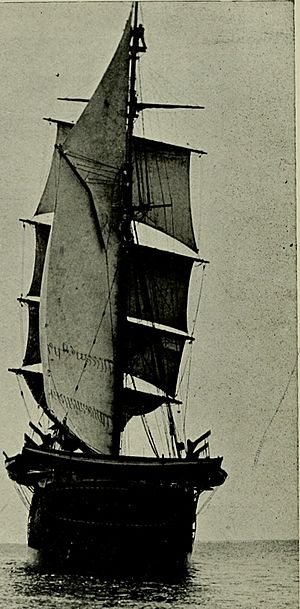Robert Cushman Murphy facts for kids
Robert Cushman Murphy (born April 29, 1887 – died March 20, 1973) was a famous American scientist who studied birds. He was known as an ornithologist, which is a person who studies birds. He worked as a bird expert at the American Museum of Natural History in New York. Murphy went on many trips across the ocean. He became an expert on birds that live near the sea. He wrote several important books about them. A type of bird, called Murphy's petrel, is named after him. Also, Mount Murphy in Antarctica and Murphy Wall in South Georgia are named in his honor.
Contents
Early Life and Education
Robert Cushman Murphy was born in Brooklyn, New York. His parents were Thomas D. Murphy and Augusta Cushman. Around 1906, when he was young, Murphy helped another bird expert named Frank Chapman. He even helped check the book Warblers of North America before it was printed.
Murphy went to Brown University for college. He finished his studies there in 1911. While at Brown University, he met Grace Alice Bairstow. They got married in 1911.
Adventures at Sea
Grace encouraged Robert to take a special job. He became a naturalist on a whaling ship called the Daisy. A naturalist is a scientist who studies nature, like plants and animals. After their wedding, the couple sailed to the Caribbean. Then, Robert went out to sea for over a year on the Daisy.
During this long trip, he wrote many notes. These notes later became his 1947 book, Logbook for Grace: Whaling Brig Daisy, 1912-1913. This book gives a look into what life was like on one of the last whaling ships. Robert became very interested in birds that live in the ocean during this time.
Studying Ocean Birds
Murphy and his wife lived in Brooklyn for a while. They had three children. In 1921, they moved to Westchester County. Robert continued his studies of sea birds. He explored islands off the coast of Peru. He wrote about the birds he found there in his 1925 book, Bird Islands of Peru.
He also joined important trips, like the Brewster-Sanford Expedition. In 1936, he wrote a very important two-volume book called Oceanic Birds of South America. Many people still consider this book a classic. He also helped plan the Whitney South Sea Expedition, which explored birds in the Pacific Ocean.
In 1951, Murphy led an expedition that made an amazing discovery. They found the Bermuda petrel, also known as the cahow. This bird was thought to have been extinct for 330 years! It was a huge rediscovery. Besides his books, Murphy wrote more than 600 scientific articles.
Awards and Recognition
Robert Cushman Murphy received many awards for his important work. In 1936, he was given the Daniel Giraud Elliot Medal from the National Academy of Sciences. The next year, in 1937, he received the Brewster Medal from the American Ornithologists' Union.
Brown University, his old college, gave him an honorary science degree in 1941. He was also chosen as a special member of the Royal Australasian Ornithologists' Union in 1939. In 1946, he became a member of the American Philosophical Society. He also received awards from other groups like the Explorers Club. From 1948 to 1950, he served as the president of the American Ornithologists' Union.
Later Life and Legacy
After retiring in 1957, Murphy moved to Old Field, New York. He became involved in protecting the environment. He joined other citizens to try and stop the spraying of DDT, a harmful chemical.
Before he passed away, a school was named in his honor. The Robert Cushman Murphy Junior High School in the Three Village Central School District was named after him.
In 1956, Murphy went on a trip to the island of Inagua. He went with Arthur Vernay to study a group of flamingos. During this trip, they met the famous writer Ian Fleming. Murphy made a strong impression on Fleming.
Murphy loved to keep detailed notes and diaries. He even kept copies of every check he wrote! He also made notes about how many times he wore his new nylon socks. Most of his personal papers are kept at the American Philosophical Society in Philadelphia. Some of his papers are also at the State University of New York at Stony Brook.
A type of fish, Trachurus murphyi, which is the Chilean jack mackerel, is named after Robert Cushman Murphy. He collected the first example of this fish off the coast of Peru.
See also
In Spanish: Robert Cushman Murphy para niños


